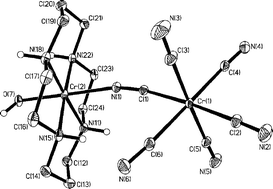The reaction of [Cr(CN)6]3− with a mixture of trans-[Cr(cyclam)(OH)2]Cl, [Cr(cyclam)(OH)Cl]Cl and [Cr(cyclam)Cl2]Cl affords the cyanide bridged dimer, trans-[HO–Cr(cyclam)–NC–Cr(CN)5]−. The tetraphenylphosphonium salt of the anion crystallizes in space group P21/n and shows a bent arrangement of the Cr1–CN–Cr2 unit with the Cr1–CN bond angle at 166.9° and CN–Cr2 at 160.32°. The Cr2–O bond, trans to the hexacyanide fragment, is very short at 1.902 Å. Two dimers are held together by two hydrogen bonds connecting the Cr2–OH group of each dimer with one of the NH groups of the cyclam ligand of an adjacent molecule, leading to an almost linear configuration. These dimers of dimers get packed parallel to each other, generating layers separated by the tetraphenylphosphonium cations. Four of the cyanide groups of the anion are engaged in H-bonds with the four water molecules present in the structure or with a NH group of the macrocycle of an adjacent molecule. From magnetic susceptibility measurements, the dimer was found to exhibit antiferromagnetic interaction between the Cr(III) centers with J
=
−16 cm−1
(Ĥ
=
−2JŜAŜB). Structural and magnetic parameters have been calculated by density functional theoretical methods at the B3LYP level. The exchange coupling constant, J, calculated for the dimer at the X-ray geometry is −23.2 cm−1 which is in excellent agreement with the experimental value.

You have access to this article
 Please wait while we load your content...
Something went wrong. Try again?
Please wait while we load your content...
Something went wrong. Try again?


 Please wait while we load your content...
Please wait while we load your content...